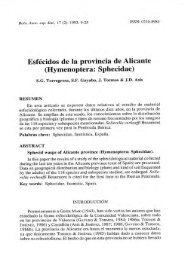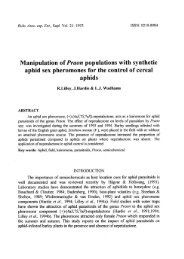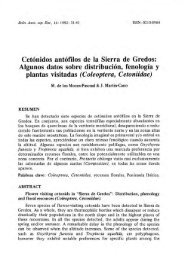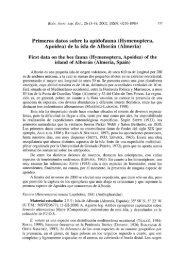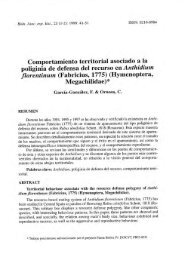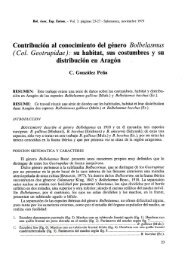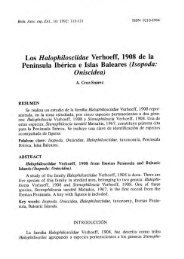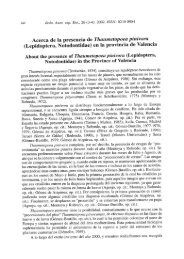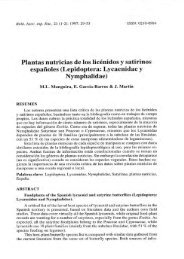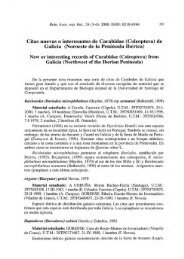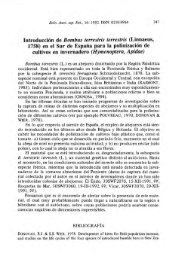Libro 1.indb
Libro 1.indb
Libro 1.indb
Create successful ePaper yourself
Turn your PDF publications into a flip-book with our unique Google optimized e-Paper software.
GALL MIDGES (DIPTERA: CECIDOMYIIDAE) OF THE IBERIAN PENINSULA 99<br />
(Fabaceae). Occurrence: scarce (Fig. 7). References: TAVARES (1902b, 1905a, 1909, 1921).<br />
Distribution: Euro-Siberian.<br />
Asphondylia dorycnii (Müller, 1870)<br />
Larvae cause galls on buds at vegetative tip of Dorycnium gracile Jord. (= D. herbaceum<br />
Vill. subsp. gracile Jord.) (Fabaceae). Occurrence: very scarce (Fig. 7); Matadepera (Barcelona,<br />
1984, new finding) leg. Pujade-Villar. References: TAVARES (1921), VILARRÚBIA<br />
(1936), SKUHRAVÝ & SKUHRAVÁ (1999), BELLIDO et al. (2003). Distribution: Mediterranean.<br />
Asphondylia ervi Rübsaamen, 1896<br />
Larvae cause galls on pods of Vicia hirsuta (L.) Gray and V. cracca L. (Fabaceae). Occurrence:<br />
scarce (Fig. 8). References: TAVARES (1902b, 1905a: incorrectly as Asphondylia<br />
melanopus). Distribution: Euro-Siberian.<br />
Asphondylia genistae (Loew, 1850)<br />
Larvae cause swellings on pods of Genista falcata Brot. (Fabaceae). Occurrence: scarce (Fig. 8).<br />
References: TAVARES (1907a, 1909), BELLIDO et al. (2003). Distribution: European.<br />
Asphondylia melanopus Kieffer, 1890)<br />
Larvae cause swellings on pods of Lotus corniculatus L. (Fabaceae). Occurrence: scarce (Fig. 9).<br />
References: TAVARES (1902b, 1931), COGOLLUDO (1921). Distribution: European.<br />
Asphondylia menthae Kieffer, 1901<br />
Larvae change into galls the flower buds of Mentha suaveolens Ehrh. (= M. rotundifolia<br />
(L.) Huds.), M. spicata L. (= M. viridis L.) and M. pulegium L. (Lamiaceae). Occurrence:<br />
frequent (Fig. 9). References: TAVARES (1907a, 1916a), COGOLLUDO (1921). Distribution:<br />
Mediterranean.<br />
Asphondylia ononidis F. Löw, 1873<br />
Larvae change into galls the axillar or terminal buds on Ononis tridentata L., O. natrix L.<br />
(= O. hispanica L.) and O. spinosa L. (Fabaceae). Occurrence: scarce (Fig. 10). References:<br />
TAVARES (1902a, 1905a), STROBL (1906). Distribution: sub-Mediterranean.<br />
Asphondylia pterosparti Tavares, 1902<br />
Larvae change into galls the flower buds or axillary leaf buds on stem of Pterospartum<br />
tridentatum (L.) Willk. in Willk. & Lange (= Chamaespartium tridentatum L., = Pterospartium<br />
cantabricum Spach., = Genista tridentata L.) (Fabaceae). Occurrence: scarce (Fig. 10).<br />
References: TAVARES (1902a, 1905a, 1909, 1916a), COGOLLUDO (1921). Distribution:<br />
Mediterranean, endemic to the Iberian Peninsula.<br />
Asphondylia rosmarini Kieffer, 1896<br />
Larvae cause small pouch galls on leaves of Rosmarinus officinalis L. (Lamiaceae). Occurrence:<br />
very scarce (Fig. 11); La Retuerta (Zaragoza, 1998), leg. Blasco-Zumeta. References:<br />
SKUHRAVÝ & SKUHRAVÁ (1999), SKUHRAVÁ et al. (2002). Distribution: Mediterranean.<br />
Asphondylia rutae Kieffer, 1909<br />
Larvae deform fruits of Ruta montana Clus. (Rutaceae) and change them in galls. Occurrence:<br />
Boln. Asoc. esp. Ent., 30 (1-2): 93-159, 2006



